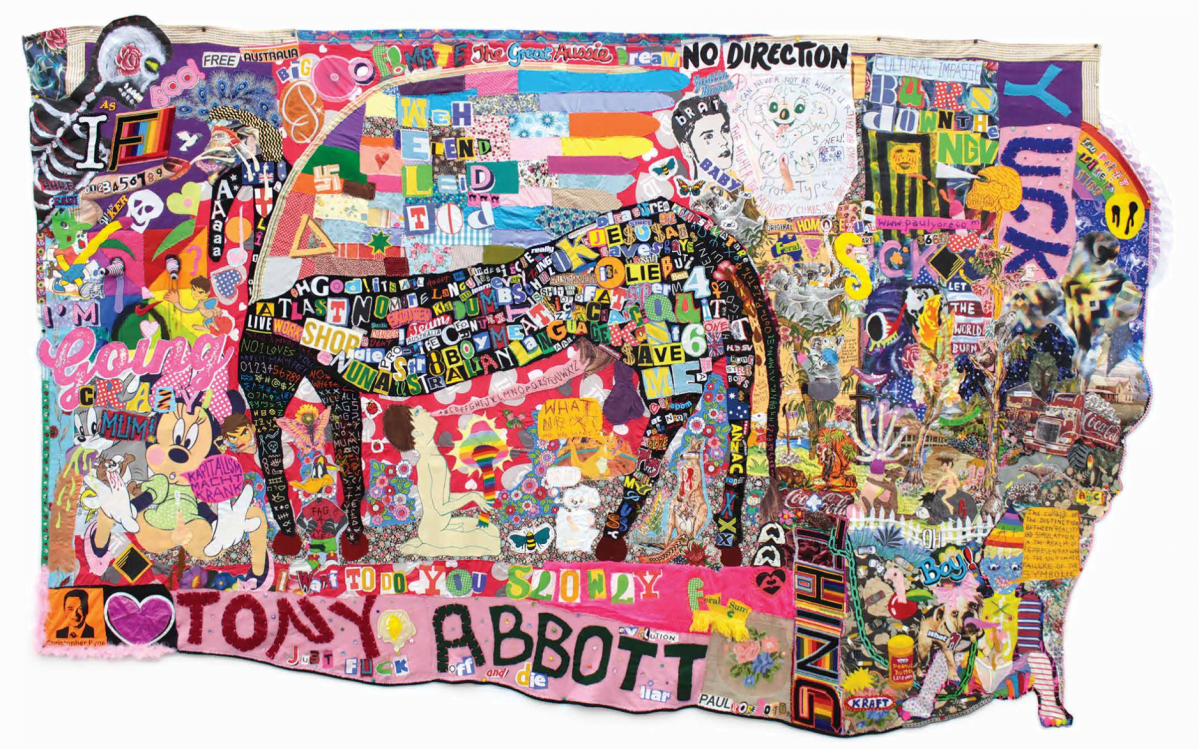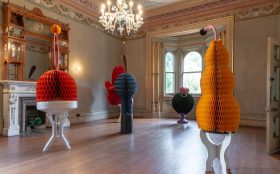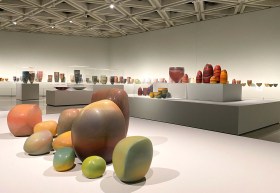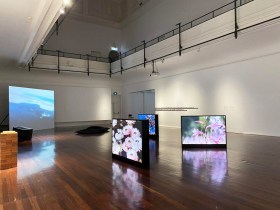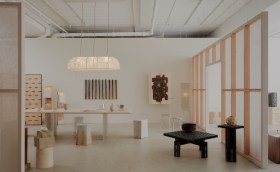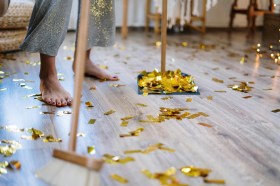Now celebrated as one of Australia’s most provoking artists and LGBTQIA+ wonder child, there was a time when the work of Paul Yore sparked outrage.
Almost hitting the decade mark since his works were dismissed against accusations of child pornography, homophobia and removed from the first iteration of Sydney Contemporary (Hugo Michell Gallery brought the artist’s work this year for a trailblazing comeback), the Australia Centre for Contemporary Art’s (ACCA) survey exhibition Paul Yore: WORD MADE FLESH opens this week to examine the artist’s career and ethos.
Characterised by painstakingly composed and brightly coloured textiles, that are sexually charged, political and confronting (though often with humour) collages of Yore never fails to stop one in their tracks.
ArtsHub previewed the exhibition with Yore and ACCA Artistic Director Max Delany, which featured over 100 works on loan from public and private collections, as well as a major new installation.
Into the world of Paul Yore
The exhibition is organised into five thematic sections traversing the past decade of Yore’s career. In the opening room painted bright yellow, Signs highlights the nuances of wordplay and linguistics while recalling inspirations such as David McDiarmid’s (1952-1995) rainbow aphorisms.
Leading to Embodiment, the second room filled from floor-to-ceiling in art salon style, Yore’s textile works gather hundreds and thousands of references, demanding the eye to pause at every glance.
Yore’s background not only in art, but also anthropology and archaeology, ties intrinsically with his practice and comes to the fore with density and intensity of works on view.
Alongside reference images from gay porn are political figures, pop cultural celebrities and cartoon figures bringing to light commentary on consumerism and commercialism.
Delany said: ’While on one hand Yore brings a whole range of disparate cultural references to explore ideas of gender fluid sexuality, on the other he explores wider debates around Australian identity and global culture.’
Read: Heteronormativity, censorship, and the queer artists facilitating change
Using fabrics and textiles, Yore’s practice can also be viewed as a balancing act between provocation and care, who often refers to himself as a ’neo-Luddite’.
Yore added: ‘I love the tradition of embroidery, needlework and quilting, even those that are old-fashioned, because they are forms that are about a sort of tactile care, making something for a loved one and also a reaction against the technological media environment today.
‘I like to think the work has a different kind of temporality about it, a slowness or like cycles,’ said Yore.
Themes examining politics and religion also comes into play in the comprehensive survey.
Yore’s large triangular banners speaks to the legacy of the Nazi Pink Triangles and its reclamation into a symbol of LGBTQIA+ pride (in a room titled Manifesto), while beaded collages of erotic godly figures are surrounded by flashing bulbs to examine contexts of belief and ritual (his father was a Franciscan priest, Delany revealed).
The kitschy, or what Yore called ’trash aesthetics’, also seeks to recalibrate our ties with decoration when slim and simple minimalist structures have been dominate in the past few decades.
Delany said: ’The other important political aspect of Paul’s work is decoration itself; the act of decoration is itself political. [His work] works against minimalism and good taste, against decor, against the classical. It relates to questions of class, decoration and also queerness.’
In the final room preceding the exhibition’s namesake installation, Word Made Flesh, is Horizon, painted an ’ecclesiastical purple’. Fabric figures seemingly pole dancing to welcome visitors into Yore’s wonderland.
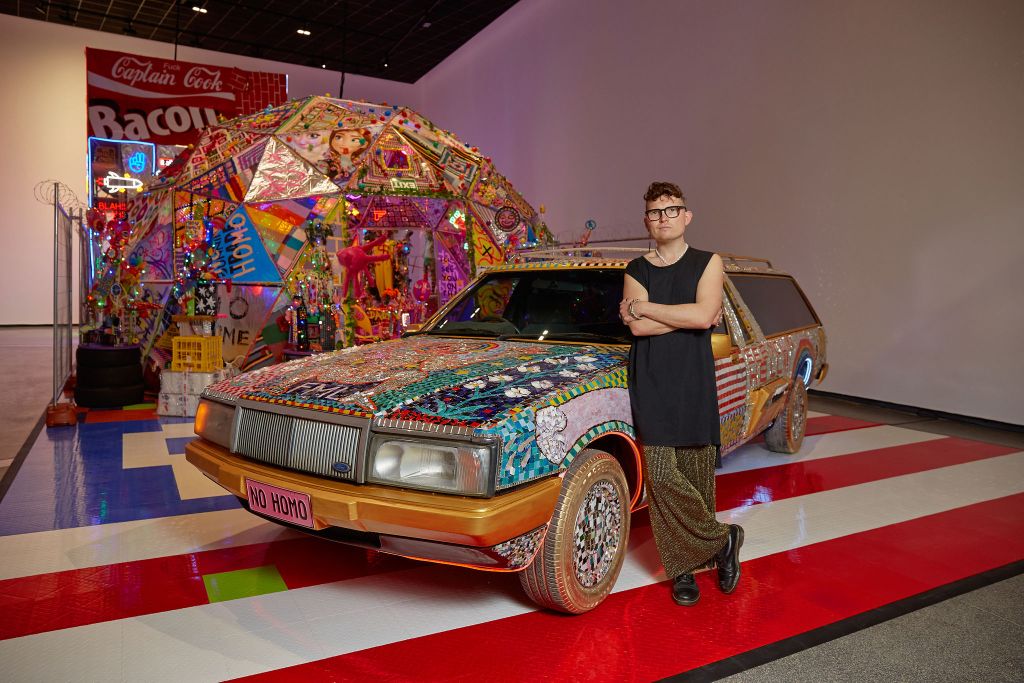
Scandals and vulnerability as a young queer artist
Yore’s works first became the centre of a heated debate in the public eye on pornography, censorship and artistic freedom in 2013 with the exhibition at the Linden Centre for Contemporary Arts (now Linden New Art). He was 26 at the time.
‘When you’re an emerging artist, you’re not really even thinking about how you might show,’ said Yore. ‘You’re just making the work and I’ve tried to stay true to that spirit.
‘That scandal around my work was both very challenging but also an opportunity for me to achieve a huge amount of growth in a very short amount of time.’
Read: What’s happening to arts censorship in the age of cancel culture?
It’s with this determination that Yore proceeded to lead a star-studded career, with works now in the collection of Artbank, National Gallery of Victoria, Bendigo Art Gallery and many others that appear throughout the exhibition.
Yore continued: ‘For me, it’s been very important to represent queerness very unabashedly and in a proud kind of way. I think there’s always going to be friction or tension [when you do that], even in the most liberal-leaning part of society because heteronormativity is such a universal institution.’
But even with such strong inclinations and iconography, Yore’s works are also laid bare and intrinsically tied a deep sense of vulnerability.
‘I’ve always told people even though my work is very bright and colourful, I’m a very serious person and my work comes from my own traumas and experiences of homophobia and mental health. I think that’s why I’m interested in making things seem very slow, because it’s also therapy and cathartic,’ shared Yore.
I think all artists feel vulnerable on some level, and I think that’s a good thing, a necessary position as an artist. Personally, I’m interested in opening up questions and proposing different ways of seeing or engaging with the world.
Paul Yore
He continued: ‘For me, the outcome [the finished artwork] is almost secondary. The methodology and the process is such a big part of what I’m doing, a constant cycle of creation, recreation and deconstruction.’
As well as the labour that goes into creating the kaleidoscope textiles and beaded collages, working mostly with found objects and second-hand materials imbues the pieces with a sense of familiarity – an aspect that Yore hopes will diverge attention from the oftentimes confronting imagery.
‘I think what the viewer adds is really important, they complete the works in a way. There are memories and relationships of familiarity. So while ensnaring the viewer in the sort of spectacle and colour, it’s also implication them back into the consequences of our material culture.
‘I think there are a lot of ambiguity [in my works] and I do see them as being very generous in some ways. Visually and materially there are a lot of different entry points for the viewer.’
The major installation Word Made Flesh, which the exhibition took its name from, is an epitome of this idea. Located in the final area of the exhibition and secluded from the gallery’s entry but unmissable as a pivot point in the show, the work is like a narrative loop.
Screens and LED banners journey though repetition on a loosely constructed tower while an igloo temple is a playfully repurposed space of gathering. Even among the overwhelming motifs, Yore hopes that there is something meditative to be gained from the experience. Together, they create ’a push and pull, a disjunction between the two forms [digital and handmade].’
Sitting at the other bookend of the gallery is a painstakingly mosaic tiled hearse – a title given to cars used to carry coffins – which Yore spent three weeks on leading up to the exhibition. The destination, heaven or hell, or perhaps a another life, is up to interpretation.
Paul Yore: WORD MADE FLESH launches with an opening event on 22 September 6pm; the exhibition runs from 23 September – 20 November at ACCA.

